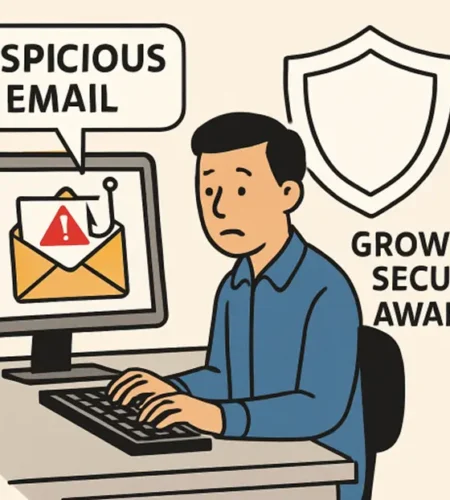Why Phishing Remains a Top Threat
Phishing continues to be the most common—and devastating—entry point for cybercriminals targeting organizations. Attackers frequently exploit human psychology, crafting convincing emails that prompt rash decisions and compromise sensitive information. With phishing attacks growing in volume and sophistication, organizations seek more advanced methods to bolster their defenses and minimize risk. Initiatives such as anti phishing training are essential in combating this ongoing challenge and empowering employees to serve as the first line of cyber defense.
While necessary, traditional security tools like firewalls and antivirus software cannot guarantee protection against every threat, particularly those that manipulate user trust. The human element remains a critical vulnerability, which underscores the value in direct training and realistic simulations—implementing a robust anti-phishing training program positions organizations to proactively reduce the chances of a successful breach before an incident occurs.
What Makes Phishing Simulations So Valuable?
Phishing simulations bridge the gap between passive learning and real-world application. By mimicking genuine phishing attempts in a safe, controlled environment, employees gain first-hand experience recognizing and responding to suspicious communications. These exercises function as assessment tools and immersive learning opportunities, producing measurable increases in vigilance. As a result, staff are more inclined to pause before clicking tempting links and more likely to report suspicious messages to security teams.
The most effective simulation programs don’t simply test employees—they drive continuous dialogue around cybersecurity and encourage growth. This holistic approach transforms occasional security reminders into an ongoing, practical learning journey.
How Often Should Simulations Be Run?
When it comes to phishing simulations, consistency is key. Studies highlighted by the Wall Street Journal show that sporadic or one-off exercises are far less practical than ongoing, unpredictable campaigns. Security professionals generally recommend quarterly or monthly campaigns, each featuring varied formats and targeting different groups within an organization. This repetition helps to “inoculate” staff against evolving phishing tactics, keeping awareness sharp and adaptability high.
With regular exposure, employees gain confidence in identifying red flags, regardless of how crafty a phishing attempt may seem. This repetition is fundamental for helping knowledge become second nature, significantly lowering the risk of a successful real attack.
Designing Effective Phishing Scenarios
Phishing simulations are most effective when they’re tailored to mirror real-life threats. Designing scenarios that escalate in complexity—from broad, generic lures to highly targeted, personalized messages—enables security professionals to test and develop employees’ abilities at every level. Incorporating elements such as urgency, requests for confidential data, or impersonation of internal leaders strengthens the exercise and exposes areas that may require additional focus. By customizing scenarios to various departments, organizations can address industry-specific threats and close gaps in specialized teams, ensuring well-rounded protection.
How Employees React & Adapt
It’s not uncommon for initial simulations to reveal significant vulnerabilities, with many employees unwittingly clicking on suspicious content. However, with well-structured and frequent simulations, users tend to show substantial improvement. Over time, they adopt a cautious approach, pausing before taking action and promptly reporting dubious emails. This growth, often reinforced by anecdotal accounts from companies with mature security programs, demonstrates the value of ongoing education in driving lasting change. Positive reinforcement, such as acknowledging staff who spot and report simulations, fosters a supportive learning environment.
Why Follow-Up Training is Crucial
After a phishing simulation, the period is critical for reinforcing key lessons and addressing individual gaps. Immediate feedback—such as alerts when a user clicks a simulated phishing link—creates “teachable moments” that make lessons stick. Brief, focused micro-trainings help users better understand what went wrong and how to correct it. Targeted, non-punitive coaching is more effective than disciplinary action for employees who fall for simulated scams. For those who succeed, public recognition can further motivate positive behaviors. Consistent follow-up transforms simulations from isolated events into powerful learning opportunities.
Measuring the Impact of Phishing Simulations
Quantifying the effectiveness of phishing simulations is essential for continued improvement. Standard metrics include click-through rates, reporting rates, and how employees respond to suspicious messages. Reviewing results over time provides insight into risk reduction and the long-term shift in employee behavior. A sustained drop in simulation “victims” often correlates with decreased successful real-world attacks and a faster, more coordinated response to incidents, boosting organizational resilience.
Building a Security-First Culture
Phishing simulations contribute to a broader security-first culture, where employees feel personally invested in protecting organizational assets. Open discussion about threats, sharing lessons learned from past incidents, and regularly celebrating security successes build a stronger, more unified team. When security awareness becomes the norm rather than the exception, technical defenses are reinforced by a vigilant, empowered workforce, substantially lowering organizational risk.
Future Trends in Phishing Defense
With cybercriminals constantly refining their tactics, organizations must stay ahead by evolving their defenses. The future of phishing simulations lies in advanced platforms powered by behavioral analytics, artificial intelligence, and personalized feedback, offering dynamic, engaging training experiences. Keeping abreast of industry news—such as updates from Cybersecurity Dive—ensures organizations remain informed and adaptive. Businesses can outpace new threats and maintain robust security postures by committing to regular, innovative training.
Regular phishing simulations strengthen security awareness by turning theory into practice, helping employees recognize and resist real-world threats. These exercises build confidence, reduce human error, and foster a culture of vigilance. Over time, consistent simulations transform the workforce into an active defense layer, significantly enhancing organizational cybersecurity resilience.
Also Read-iPhone Jokes: Hilarious Tech Humor to Brighten Your Day


Comments